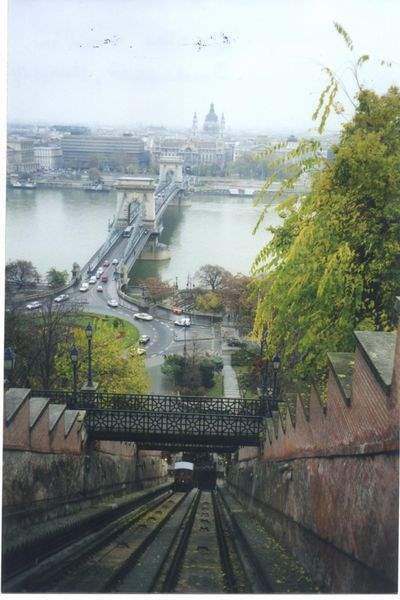
Breathtaking Budapest
1/13/2001
A trip down Castle Hill on the Siklo funicular offers a dramatic view of Pest and the Chain Bridge spanning the Danube River.

A trip down Castle Hill on the Siklo funicular offers a dramatic view of Pest and the Chain Bridge spanning the Danube River.
BUDAPEST - Someone's always in hot water here. It's been that way for thousands of years because Hungarians of all stripes have found the allure of thermal baths bubbling up from the Carpathian Mountains quite irresistible.
Who would think, on a late November day with the temperature in the 40s, of dipping into an outside pool and finding plenty of company to boot? Yet at mid-day, dozens of people flocked to the pale yellow Baroque fantasy known as the Szechenyi Baths, in Budapest's splendid City Park. One of 14 such natural springs open for public soaking in the city, it's among some 1,000 in this ancient crossroads country.
In a spartan health club setting, bathers changed, stashed belongings in lockers, took a quick rinse in a shower (mandated), grabbed a towel, and headed outdoors. There are indoor pools here, but who would miss the pleasure of easing down shallow steps into 140-degree water as steam rises in graceful clouds, to stroll slowly in chest-high water, chatting under pale sunshine. Gaggles of older men clustered around two permanent chess boards inlaid in stone tables jutting into the pool, kibbitzing endless games. More ambitious bathers stroked out laps in an adjacent pool as lifeguards looked on. The experience - 20 minutes is the recommended stay - costs under $2. Saunas and massages are available for extra charge.
But if baths offer relaxation and health, they are but one of countless attractions in a city that is showing signs of both capitalism's rebirth and popularity with tourists. Not that this fascinating Eastern European capital has ever lacked enthusiastic visitors ready to hang up a Home Sweet Home sign.
A stop in the Budapest History Museum - one of countless educational institutions ranging from fine arts and crafts to fire-fighting and telephone history - reveals just how many peoples have claimed this turf. Ongoing excavations outside the museum - part of several cultural showcases within the complex of stone and brick buildings called Buda Castle crowning Castle Hill south of the river - reveal more and more history.
There were the Celts. The Romans who called this area Pannonia, the northernmost outpost of the empire. The Mongols. The Turks. The Magyars. The elegant Hapsburg dynasty . The ruinous Third Reich and Soviet regimes. All have left their marks here, for better or for worse, adding to the complex lore and the sort of serendipity travelers adore.

In a tiny cubbyhole of a shop, this vendor shows some of his thousands of silk scarves.
Take the Labyrinth below Castle Hill, a series of dark, dank limestone tunnels and caves a dozen feet below the surface. Formerly used as an armory, a wine cellar, and an air raid shelter, the natural wonder today has been reshaped by young artists and entrepreneurs into an off-beat attraction. Visitors can follow a guide or lead themselves through a twisting network of dripping, low-ceiling spaces lit only by an oil lamp. Out of the gloom loom odd artifacts, some real reminders of past times, others tongue-in-cheek “evidence” of visitors from space.
Another reminder of Budapest's mixed parentage is Matthias Church, unofficially named for the 15th century Hungarian king who was married there twice. The original 13th century structure shows the effects of many cultures in its Gothic spires and soaring arches, stained glass windows, and ornate carvings inside and out. Yet within, remnants of its service as the main mosque of Turkish overlords for 150 years show in the thoroughly decorated walls, columns, and ceilings, typical of Islamic design.
Just outside the church is the Fisherman's Bastion, a neo-Romanesque cluster of arches, towers, and walkways overlooking the city, a former fish market morphed into picturesque tourist attraction.
Next door is a medieval monastery wrapped by a thoroughly modern Hilton Hotel, offering time-warp moments as one steps from the 21st to the 13th century and back.
From the Castle, the Siklo funicular whisks visitors down to the Chain Bridge, named, like the baths, for Count Stephen Szechenyi, Hungarian reformer and philanthropist. This suspension span is the oldest and most beautiful of the city's eight bridges linking Buda and Pest.
Ironically, for its deep urban roots, Budapest itself came into existence in 1873, when visionaries realized the value of uniting two separate towns into one more powerful entity. While history resonates more clearly on the hilly Buda side, the business of being a city and a country's capital takes place mostly on the Pest side, a plain bisected with a series of curving boulevards revealing early efforts at city planning.
Here is shopping on the twisting Vaci Utca, the Fifth Avenue of Budapest, loaded with shops offering everything from silk scarves to porcelain, apparel, records, and dotted with coffee shops. At the end is the Grand Market Hall, a huge glass-roofed market where shoppers select from a bounty of peppers and other produce, spices, meats and fish, year-round.
The coffee shop to end all is Gerbeaud, the venerable landmark confectionery where one sips cups of dark Hungarian coffee while sampling Dobos torte, Kugler cake, Kossuth Crescents (named for another national hero, Lajos Kossuth), and chocolates, displayed like gems in gleaming cases within turn-of-the century splendor. (A brewpub downstairs now dispenses good microbrews and meals featuring food for which this nation of hoteliers and restaurateurs have become well-known.)
Getting around to all these attractions and many, many more couldn't be easier, once one obtains a transit pass. Budapest boasts the oldest subway system in continental Europe, a three-line marvel that covers both sides of the Danube River. Connecting to it are wonderful trams that bump along into the suburbs, and a complex network of buses.
Even more amazing is the cogwheel railway, an 1874 original rising steeply above the rooftops of Obuda (Old Buda) via the same mechanism that lifts roller coasters. At the top, another phenomenon is the Children's Railway, a remnant of Budapest's Socialist era that runs seven miles along the crest of another hill.
Although an adult is always in driving the little train, children ages 10 to 16 take turns as conductor and station hand.